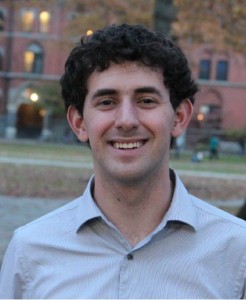
“There’s a rare moment when you realize you have something to contribute, you hope, and I think that’s what gets me excited. It’s the scale and importance and scope of the problem and the fact that I can actually do something about it,” says Aaron Feuer, a senior in Ezra Stiles. By combining his interests in programming and education reform, Feuer is working to improve the educational system through Panorama Education, the startup company he co-founded with Xan Tanner PC ’13, David Carel PC ’13, and John Gerlach TC ’14.
Feuer attended a big inner city urban high school in Los Angeles. As president of the California Association of Student Councils, he already had experience with finding ways to engage students with their schools. At the end of his senior year, he was astounded that of a freshman class of 1600 students, only about 800 graduated. Describing the high school dropout rate as “ridiculous,” Feuer was driven to pinpoint the reasons for such scholastic problems.
“We want to offer intelligence, the same way the military gathers intelligence. We need to diagnose what’s wrong. I’m really excited that, working with the Los Angeles school system now, we can go back and figure out what’s wrong with schools like mine,” says Feuer.
To accomplish this, Feuer turned to his interest in coding and programming. He began coding in fourth grade and has worked as a freelance web developer and programmer in projects ranging from a desktop widget app for Google to album promotion for Madonna to a Facebook app for National Public Radio. Using these skills, his idea was to offer information derived from analyzing surveys to help schools achieve their goals in solving their most pressing problems, including improving the graduation rate, stopping bullying, and retaining excellent teachers. This is critical because many problems, Feuer notes, are not immediately transparent.
The summer after his freshman year at Yale University, Feuer applied for Yale fellowship funding with the intent of building a system for student council members in public schools to conduct teacher-feedback surveys using paper forms. The project was called Classroom Compass, but by the fall semester of his junior year, only a few schools had adopted the technology.
He decided that the project was not moving quickly enough, and so in the following January, he recruited three other Yale students to found a new system. This time, Feuer and his group were fueled by a total $50,000 grant: a $25,000 grant from the Yale Entrepreneurial Institute (YEI) and other Yale fellowships, and another $25,000 grant won from a YEI pitch competition. That summer, Feuer and his team worked on coding a new analytical system almost completely from scratch, using only the skeleton from Feuer’s original code for Classroom Compass. The project effectively transformed from the one-dimensional Classroom Compass, a tool for teachers to collect feedback from their students, into Panorama Education, a 360-degree feedback system that was more comprehensive in the design, analysis, and presentation of survey information.
As CEO and lead developer for Panorama Education, Feuer wrote the basic algorithms that underlie Panorama’s technology. One innovation is the usage of white paper instead of traditional Scantron forms for their surveys, which are much more expensive to print. After having students fill out surveys sent by Panorama, the papers are then returned and scanned, and afterwards, computers collect information about the students’ choices. Feuer designed the algorithms necessary to analyze the scanned surveys and extract the appropriate information, rotating the scanned piece of paper into the right configuration and overlaying a grid structure to find filled multiple choice answers and record them.
But the “game-changing technology” that distinguishes his company is the algorithms that Panorama is developing to make the information it collects more accessible to educators. A lot of information about schools is collected — things like student attendance records, student discipline records, and previous student survey results. Given the vast quantity of data, most of it is hard to interpret and visualize. For Panorama, Feuer wants to think about the process in which a human would think about this data, automate the thinking process through algorithms, and output the results in a clear and coherent way.
Some of the factors involved in these analysis algorithms include different groupings of students (such as by gender and race), how questions in surveys are linked, and the relative deviations in the student’s hand as he fills out a form. The result is a comprehensive analysis, taking into account a complex interplay of factors and presented in a rational, beautiful way. Feuer hopes that these analyses will reveal important insights for schools in ways that basic human observations cannot determine without hard data.
Panorama is snowballing. In this past week, it added 380 additional schools for “a really good week,” as Feuer says. The company is currently working in six states, collaborating with organizations including two state governments, major school districts, and Teach for America-Connecticut. Feuer hopes Panorama will expand even further. “Every school in America should be using this,” Feuer remarks with a wry smile.
